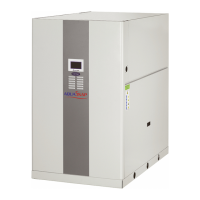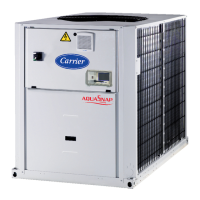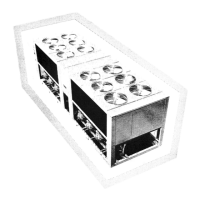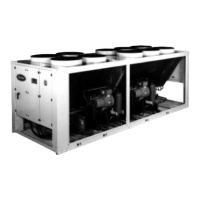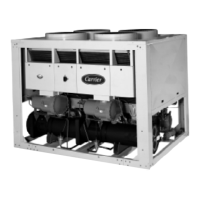15
The table below summarises the unit control type and stop
or go status with regard to the following parameters.
• Operating type: this is selected using the start/stop
button on the front of the user interface.
LOFF: local off, L-C: local on, L-SC: local schedule,
REM: remote, CCN: network, MAST: Master
• Remote start/stop contacts: these contacts are used
when the unit is in remote operating type (Remote).
See sections 3.6.2 and 3.6.3.
• CHIL_S_S: this network command relates to the unit
start/stop when the unit is in network mode (CCN).
• Command set to Stop: the unit is halted.
• Command set to Start: the unit runs in accordance
with schedule 1.
• Start/Stop schedule: occupied or unoccupied status of
the unit as determined by the unit start/stop program
(Schedule 1).
• Master control type. This parameter is used when the
unit is the master unit in a two chiller lead/lag arrange-
ment. The master control type determines whether the
unit is to be controlled locally, remotely or through
CCN (this parameter is a Service configuration).
• CCN emergency shutdown: if this CCN command is
activated, it shuts the unit down whatever the active
operating type.
• General alarm: the unit is totally stopped due to failure.
- - - - - - - - - - Active - - O
- - - - - - - - - - - oui - O
- - - - Active - O - - - - - CCN O
- - - - Active - - - - Unoccupied - - CCN O
- - - - - Active O - CCN - - - CCN O
- - - - - Active - - CCN Unoccupied - - CCN O
- - - - Active - On - - Occupied Disabled No CCN On
- - - - - Active On - CCN Occupied Disabled No CCN On
Active - - - - - - - - - - - Local O
- - Active - - - - - - Unoccupied - - Local O
- - - - - Active - - Local Unoccupied - - Local O
- Active - - - - - - - - Disabled No Local On
- - Active - - - - - - Occupied Disabled No Local On
- - - - - Active - - Local Occupied Disabled No Local On
- - - Active - - - Open - - - - Remote O
- - - Active - - - - - Unoccupied - - Remote O
- - - - - Active - Open Remote - - - Remote O
- - - - - Active - - Remote Unoccupied - - Remote O
- - - Active - - - Closed - Occupied Disabled No Remote On
- - - - - Active - Closed Remote Occupied Disabled No Remote On
Master/slave control is not active, or it is active and unit is
the master unit:
In the On, Stopping or Delay modes and if the unit is
stopped the pump is started up and continues to operate
for 20 seconds after the compressor has stopped. It is
stopped if the boiler is active, but could be started up due
to the capacity limitation function.
Master/slave function is active and unit is the slave unit:
The pump is started up, when the unit is started up and if
the demand limit is above 1%. Otherwise the pump will be
stopped 30 seconds after the last compressor has stopped,
except if the configuration parameter "lag_pump" has been
configured to turn the pump even if it has been set to stop.
In this case the pump will run continuously.
A periodical quick pump start-up has been configured:
The water pump is started up each day at 14.00 hours for
two seconds.
This contact checks the status of a loop (water flow switch
and customer safety loop, see chapter 3.6). It prevents the
unit from starting if it is open when the delay at start-up
has expired. This open contact leads to an alarm shut-
down, if the unit is running.
The heater for the heat exchanger and the water pump
(for units with a pump) can be energised to protect the heat
exchanger, if it may be damaged by frost, when the unit is
shut down for a long time at low outdoor temperature.
NOTE: Heat exchanger heater control parameters can be
modified, using the Service configuration.
The control point represents the water temperature that
the unit must produce. The heat exchanger entering water
temperature is controlled by default, but the heat exchanger
leaving water temperature can also be controlled (requires
a Service configuration modification).
Control point = active setpoint + reset

